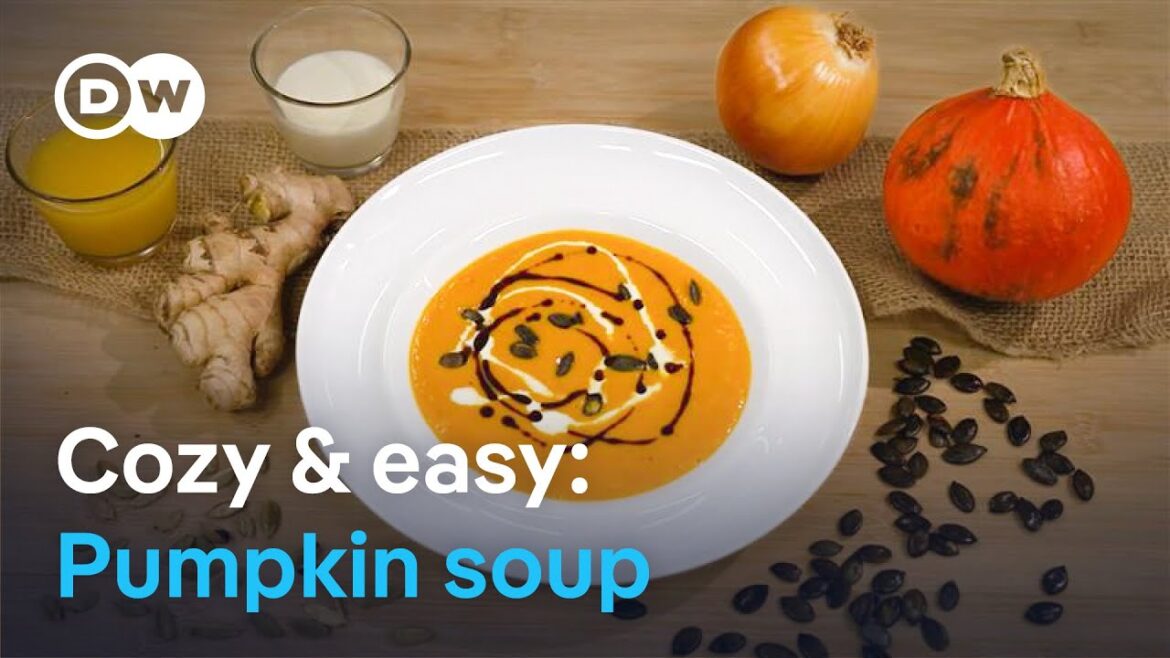Discover the ultimate cozy fall recipe: German pumpkin soup. At Parkcafé restaurant in Ludwigsburg, chef Laura Leidig shares her favorite version, using Hokkaido squash, ginger and a splash of orange juice. We also visit the world’s biggest pumpkin exhibition in Ludwigsburg and learn which pumpkins are safe to eat. Whether you’re vegan or just love comfort food, this soup is perfect for chilly evenings.
CHAPTERS:
00:00 What Germans love about pumpkin soup
00:21 Meet chef Laura Leidig
00:50 Pumpkin exhibition in Ludwigsburg
01:09 Which pumpkins are safe to eat?
02:00 Pumpkin origins and cultivation
02:19 How to cut a pumpkin (hack!)
03:11 Don’t waste the seeds!
03:22 Step-by-step recipe
04:23 Creamy finish (vegan option!)
CREDITS:
Report: Lisa Rensch
Camera: Marc Bürkle
Edit: Josefine Funck
Supervising Editors: Hendrik Welling, Jana Oertel
#dweuromaxx #pumpkin #germany
————————————————————————————
Subscribe to DW Food:
https://bit.ly/DWFood_Sub
DW Food brings you the perfect blend of culinary trends, easy DIY recipes, exciting food secrets & a look behind the scenes of Europe’s culinary culture.
The color alone can make you feel warm inside! Pumpkin soup – a German favorite
perfect for the start of the cold season! At the Parkcafé restaurant in Ludwigsburg, Laura Leidig shows us how to make a proper pumpkin soup. It’s not difficult. We’ll get to Laura’s favorite variation shortly. But first, let’s dive into the wonderful world of pumpkins! We visit the world’s largest pumpkin exhibition
in Ludwigsburg near Stuttgart. There are some 700 varieties
on show here, but beware! You can’t serve up any old pumpkin! Ornamental gourds like these, with their funky colors
and shapes, are just for show. Not the case for the beloved butternut squash, fortunately. Most pumpkins are harvested from the beginning of August. But some varieties need to ripen longer
and can only be harvested in autumn, like this ‘jack-o’lantern’. It was bred specifically for Halloween. While they’re perfectly edible
and great for a warming soup, many prefer to carve them into ghoulish lanterns. Originally, pumpkins were native
to Central and South America. They arrived in Europe after the voyages of Columbus. Today, pumpkins are grown worldwide. European leaders in pumpkin cultivation
are Ukraine, Spain, and Italy. But how to turn a pumpkin into a delicious soup? For this recipe, Laura uses
Hokkaido or butternut squash. The biggest challenge is
cutting the large, hard fruit. But she shows us a hack for easy carving. So, you can eat the skin, but what about the seeds? Rather than throwing them away,
try roasting them in the oven, whole or shelled. For Laura’s favorite pumpkin soup,
she uses finely chopped ginger and diced onions. Then, it’s time to add the pumpkin. For acidity, Laura adds orange some juice. Then, the soup is topped up
with vegetable broth. To get that beautifully silky consistency,
cream is a must. And it’s vegan-friendly, too.
Just use coconut milk instead. Cook down for about 20 minutes,
and voila: the soup is ready for puréeing. There’s nothing quite like a bowl of pumpkin soup
to capture the essence of fall. A true comfort food for a cozy evening in
as the days get shorter.


7 Comments
I want carrots and potato in my pumpkin soup….
Swapping ginger for smoked paprika.
Using home made chicken stock.
Love from Norway
❤😊
bundeva , Shonetove Svinjarije – radio
Roasted pumpkin soup is one of my favorite 😊 guten appetite
What do the Amish do around Halloween Time?
They “Pump” Kin
They mention pumpkins are a product that comes from Central and South America, however natives North American nations had it grow in a combination with beans and maize known as the three sisters for thousands of years.
I love the Fall. It’s just the best time of the year here in NYC. My nana made butternut squash soup and I am surprised this recipe didn’t include or mention Nutmeg. That’s what my nana made butternut squash soup with.
Isegi mina Eestlane söök seda suppi hea meelega ja küsiks juurde kui väheks jäi.